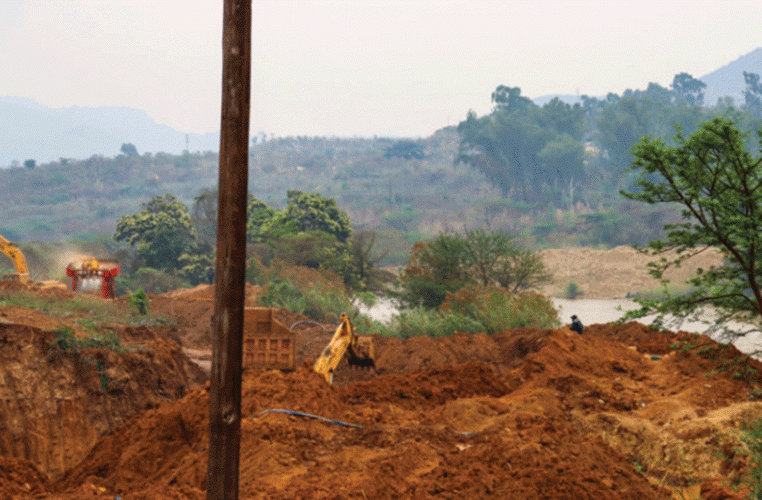
THE bus lurches and sways, sending passengers clutching onto their seats as it navigates the treacherous dust road.
The driver expertly manoeuvres around massive potholes, but the ride is still a bone-jarring test of endurance.
As the bus approaches the St Augustine Turn-Off Bridge, a tiny, a single-lane structure that spans a dry riverbed, the stakes are raised.
The bridge’s cracked and worn surface seems to defy gravity, threatening to collapse under the weight of the bus and its occupants.
This is the daily reality for commuters travelling between Tsvingwe residential area and Mutare, with no alternative route to take.
This dangerous bridge lies within the gold-rich area of Penhalonga in Manicaland province, where mining companies are extracting gold worth millions of dollars.
Yet, the community is left to contend with crumbling infrastructure, putting lives at risk every day.
Penhalonga is a small peri-urban area laden with rich mineral deposits, but is reeling from underdevelopment

With gold mining at its core, the community grapples with crumbling infrastructure, inadequate social services and a growing sense of disillusionment.
Penhalonga has long been a hub for gold mining, with Better Brands Mining Ltd operating in the area, overseeing 132 claims at the historic Redwing Mine.
Despite the significant revenue generated by these activities, the community remains largely neglected.
According to the Centre for Research and Development (CRD), a staggering 532 gold claims are tied to a network of political elite and foreign investors, particularly Chinese nationals, many of whom operate without proper documentation or compliance with environmental regulations.
A taskforce led by the Joint Operating Command, which includes the Zimbabwe Republic Police and the Mines and Mining Development ministry, has failed to curb these activities.
As a result, the community is left to contend with the consequences of unchecked mining practices, including environmental degradation and a lack of basic services.
Westone Makoni, chairperson of the Penhalonga Residents and Ratepayers Trust, voices the community’s frustration.
“We have seen companies mining gold for years, but our community remains underdeveloped. We need better roads, schools, and healthcare facilities,” Makoni said.
Lloyd Sesemani from the Zivai Community Empowerment Trust highlights the disparity between the wealth generated and the community's dire needs.
“Despite being one of the mineral-rich areas in Manicaland, Penhalonga fails to access basic services like education, health, and clean water,” he said.
“Corruption and gold smuggling have crippled our efforts to leverage our resources for community benefit.”
The lack of transparency in the mining sector only exacerbates these issues.
Many companies refuse to disclose production and sales figures, citing “commercial sensitivity”.
This secrecy raises concerns about accountability and the government’s ability to effectively regulate the industry.
James Mupfumi, director for the CRD, emphasises the need for the government to eliminate political interference in the mining sector.
He urged Fidelity Gold Refinery to enforce responsible sourcing policies that ensure transparency and compliance with legal standards aimed at combating illicit financial flows.
“There is nothing to talk about in terms of development,” Mupfumi laments.
“We need to see real changes — better infrastructure and empowerment projects for the community.”
Clinton Masanga, the director for Penhalonga Youth Development Trust, echoes similar sentiments, stressing the community’s demand for environmental protection and equitable distribution of mining benefits.
“The community is not benefiting from these mining activities. We need a fair share of the wealth beneath our feet,” Masanga said.
Evermore Mubati, a member of the Tsvingwe Residents Association, called for urgent reforms.
“We need greater transparency and accountability from mining companies and the government. Our voices must be heard,” Mubati said.
However, the political elite often shield those involved in mining from scrutiny, leaving residents feeling powerless.
Activist Bright Maunga noted the long history of inaction and the lack of political will to hold powerful interests accountable.
President Emmerson Mnangagwa, during the Mine Entra conference, held recently urged the mining sector to prioritise community development, emphasising that mining profits should be reinvested into local projects.
He called for a shift from mere resource extraction to creating tangible benefits for communities.
Yet, the gap between promises and reality remains wide.
Penhalonga residents continue to wait for the wealth beneath their feet to translate into a brighter future — a future marked by well-maintained roads, accessible healthcare and a thriving community.
As the gold continues to flow from their land, the people of Penhalonga are left grappling with the question: When will their community rise from the shadows of neglect into the light of prosperity?
The answer remains elusive, but their voices grow louder, demanding change.










